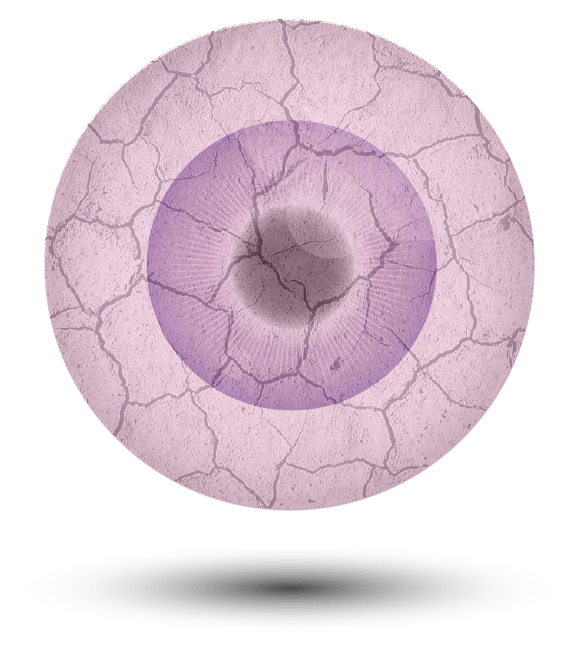Dry eye
Dry eye is very common, with 1 in 10 Australian adults experiencing signficant problems from their dry eyes.
Dry eye is a very common problem that can occur in any age group, but is a particular problem in the older adult. About 1 in 10 adults in Australia will experience significant dry eyes.
Dry eyes occur due to a problem with the production or retention of the tear film on the surface of the eye. The tear film is very important for maintaining a healthy and comfortable eye, and is also an important part of the optical system that allows us to see clearly.
There are many factors that can cause or worsen dry eye. These include:
- Increasing age.
- Hormonal changes. Particularly after menopause
- Dry, dusty, windy, smoky condition, or the use of air-conditioning or heating.
- Screen time. Excessive use of phones, tablets, computers, TV
- Medications. Such as anti-depressants, anti-histamines and certain blood-pressure medications with beta-blockers in them.
- Contact lenses.
- Eyelids not closing properly. From disease or present in some patients when they sleep.
Dry eye can present in many different ways, with different symptoms in different patients. Common symptoms include:
- itchy, scratchy, burning, foreign-body sensation, or stabbing pains
- tired eyes
- frequent blinking of the eyes
- intermittent misty vision, which clears on blinking
- “watery eyes”
It is important to recognise that dry eyes can cause watery eyes. This is a reflex mechanism by the eye to try and “treat” the dry eye. This reflex watering will often occur when outdoors or in windy, dry and dusty conditions.
Dry eye symptoms are often worse at the end of the day and first thing in the morning. They are also worse after any visual activity such as reading or computer work. This is because you do not blink as much whilst performing these activities, which accelerates loss of the tears from your eyes.
Dry eye is not usually sight-threatening. However, a smooth and uninterrupted tear film is very important for clear vision. The tears also nourish and oxygenate the cornea of the eye, which is vital for clear vision.
There is no cure for dry eye. However, there are many treatments available that can help reduce the symptoms of dry eye. The success of these treatments depend on how well and how often they are applied, and will need to be used long-term.
1. Artificial tears for dry eye
The most important treatment for dry eye is the use of moisturising or artificial tears. These may come as eye drops, gels or ointments/creams. There are many products on the market, with no product shown to be superior to any other.
The success of treatment depends on the frequency at which the tear replacements are used. For most patients with dry eye, a minimum of 4 times a day is required. In severe dry eye, you may be started on an intensive regime of 1-2 hourly drops, and then weaned down to a more manageable maintenance dose.
Artificial tears may come in preserved or non-preserved forms. If you are using tears more than 4 times per day, a non-preserved lubricant should be prescribed to avoid any toxicity or irritation from frequent use of preservatives.
Drops are easier to use than gels or ointments, but do not last as long. Gels and ointments are messier to use, and may temporarily blur the vision, but last longer in the eye. Each patient needs to find the combination of lubricants that suits their lifestyle best. Most patients will use drops/gels during the day, and an ointment at night before bed.
2. Lifestyle measures to improve dry eye
As well as artificial tears, patients with dry eye should also:
- Drink plenty of water during the day
- Consider fish oil or flaxseed oil supplements (if not contraindicated)
- Remember to blink frequently, especially when using screens
- Optimise your environment. Avoid dry, dusty, windy conditions. Wear wrap-around sunglasses when outdoors. Avoid air-conditioned or over-heated rooms. Use a humidifier.
3. Specific measures to improve dry eye
Many patients with dry eye also have blepharitis Treatment of blepharitis with warm compresses and eyelid scrubs can greatly improve dry eyes.
Click here to read more on Blepharitis
If you are a contact lens wearer, minimise the time of lens wear. In some cases, a different type of lens be better tolerated if you develop dry eye.
If you are on any medications that exacerbate dry eye, consult your general practitioner to see if they can be ceased or changed to an alternative medication.
4. Plugging the tear duct.
The tears normally drain into 2 small openings in the inner eyelids (one in the upper eyelid, and one in the lower eyelid), known as the puncta. These are the entry points into the tear drainage system, which continues into a tear sac (lacrimal sac) and a tear duct (nasolacrimal duct) located in the nose. That is why our nose runs when we cry.
In severe dry eyes, where artificial tears are not sufficient, occlusion of the puncta may be performed by Dr Then. This reduces the drainage of tears out of the eye and can help keep the eye moist for longer. Usually only the tear ducts in the lower eyelids are closed. The tear duct opening are plugged with tiny silicon plugs which remain permanently in place. This is a quick, painless and simple procedure performed in the clinic, with no need for any anaesthetic. Tears can still drain around the plugs, but at a much slower rate. If they cause any irritation or over-watering of the eye, they can be just as easily removed.
Click here to download the RANZCO information form on Dry Eye
Patient information for insertion of punctal plugs for dry eye with Peel Vision
Blepharitis
Blepharitis is inflammation of the eyelid margin.
It is a common and irritating problem that often occurs with dry eye.
Blepharitis is inflammation of the margins of the eyelid. It is a very common condition that usually presents in both eyes and can affect people of all ages, including children.
Blepharitis is due to a variety of causes, and there may be more than one cause in each person. These include:
- Bacterial (Staphylococcus) infection of the eyelids
- Scalp dandruff (seborrheic dermatitis)
- Acne rosacea
Blepharitis is a chronic ongoing condition. It is not known why the inflammation develops and persists in some patients, and not others. There is no cure for blepharitis, but there are treatments that can greatly minimise the symptoms and complications associated with this eyelid inflammation.
Most people will experience one or more of the following symptoms from their blepharitis:
- Grittiness
- “foreign body” sensation
- Burning
- Itching
- Frothy tears
- Sensitivity to light
- Crust on the eyelashes (especially in the morning)
- Red swollen eyelids
- Red eyes
Blepharitis is best diagnosed by examination under a high-powered microscope.
Symptoms will persist or worsen if blepharitis is not properly treated. In some cases, complications may occur from the blepharitis which include:
- Stye – painful red lump on eyelid due to infection at the base of the eyelashes)
- Chalazion/Meibomian cyst -painful or painless lump in the eyelid due to trapped fatty secretions
- Dry eyes
- In-turned eyelashes that rub on the surface of the eye
Blepharitis is not usually a threat to vision. However, having eyes that that are constantly uncomfortable, red or dry does impair overall visual function and quality of life.
There is no cure for blepharitis, but treatment can improve the symptoms of blepharitis, and reduce the risk of complications. These treatments will need to be applied for the long-term, and include:
1. Cleaning of the eyelids (eyelid scrubs)
2. Warm compresses
Occasionally, in cases of severe inflammation (redness and swelling), your ophthalmologist may also prescribe a short course of antibiotic eye ointment, anti-inflammatory eye ointment or oral antibiotics (doxycycline tablets) to help control the inflammation.
Newer treatments for blepharitis have recently emerged and are proving helpful for some patients. They include the use of IPL laser and eyelid-massaging treatments to squeeze the oily glands (eg LipiflowTM). Dr Then may discuss these with patients if they are eligible.
You will need:
- Cotton balls or gauze or soft face-towel
- Baby shampoo
- Large cup of warm (tap or boiled) water
Put 2-3 drops of the baby shampoo in the warm water. This should be a very dilute solution so that it does not sting the eyes excessively. Dip the cotton balls/gauze in the soapy solution. Close your eyes and wipe along the crease of the eyelids, where the upper eyelid meets the lower eyelid, several times. Only wipe the skin. Try not to wipe the INSIDE (wet) part of the eyelid. Then rinse thoroughly with water.
You may also apply the lid scrubs whilst in the shower, applying the baby shampoo onto a face towel and gently cleaning the eyelids under the warm running water of the shower.
Eyelid scrubs should initially be applied twice per day (morning and night), then once per day long-term.
These compresses are very good for relieving redness, swelling and itching of the eyelids. Warm compresses can be made with a clean face towel soaked in warm (boiled) water, or a moist towel warmed in the microwave (be careful not to burn/overheat the towel). These compresses should be applied to CLOSED eyelids for about 5 mins at a time. Always test the temperature of the compress on the back of your hand before applying to your eyelids, to avoid burning yourself.
Whilst your blepharitis is active, it is a good idea to temporarily stop wearing eye-liner/mascara/eye-shadow until your inflammation in under control. Always ensure that you thoroughly remove any eye make-up before bed, and apply your eyelid scrubs after make-up removal.
Whilst your blepharitis is active, you should temporarily stop wearing your contact lenses until the inflammation is under control. Active inflammation and infection of your eyelids can reduce your tolerance for contact lens wear, as well as increase your risk of contact lens-related eye infections.
If you apply your treatment correctly and diligently, most people will achieve excellent control of their symptoms.
However, it is important to always consult your ophthalmologist if your symptoms do not improve despite good treatment. In rare cases, certain eyelid tumours (sebaceous carcinoma) can mimic the symptoms and signs of blepharitis. If Dr Then suspects this, she will perform a small biopsy of the eyelid to rule this out.
Click here to read the RANZO Information leaflet on Blepharitis
Watery eyes
A watery eye has an excess of tears in it, which may spill-over onto the cheeks. It can affect one or both eyes. A watery eye can be very uncomfortable, interfere with vision, and be socially embarrassing for some people.
The water in our eyes are called tears. Tears are constantly produced to help wash and clean the eye, and tears drain out of the eye through a tear duct. So the tear system works very much like a tap and drain. The eyelids can be considered the basin that holds the tears on the surface of the eye.
The tears in our eyes are produced by a gland located in the outer corner of the upper eyelid (The Tap). Tears wash across the surface of the eye and drain into the tear duct system which is located in the inner corner of the eye and continues into the nose and throat (The Drain). This is why our nose runs and we taste tears in the back of our throat when we cry.
Watery eyes occur when there is an imbalance between tear production and tear drainage. Either too much tears are being produced, the tear drainage is blocked, or the tears are not being pumped towards the tear drain.
1. Too many tears being produced
This is usually in response to irritation of the eye. Irritation of the eyes leads to reflex watering of the eyes. Dry eyes and blepharitis are the two commonest causes of reflex watering. Irritation from dust, smoke, pollution, foreign body or an in-turned eyelash can also cause sudden and quick watering.
Click here to read more on Dry eye and Blepharitis
2. Tear drainage is blocked
The tear drainage system is very complex. It start with 2 drainage holes in the inner eyelids, then follows through a tubing system that runs down the nose and into the back of the throat. Any part of this system can become blocked, most commonly from age-related changes but sometimes from disease, trauma or surgery to the eyelids, nose or sinuses.
3. Tears are not pumped properly across the eye toward the tear drainage system
This is usually due to problems with the eyelids. As we age, the lower eyelids stretch, become lax, and may even turn abnormally inward (entropion) or outward (ectropion). This can lead to reduced pumping action of the eyelids that helps tears move across the eye toward the drainage system.
Click here to read more about Lower eyelid Ectropion and Entropion.
Most patients with watery eye have more than one of these causes.
Patients with watery eye have one or more of the following symptoms:
- Wet eyes
- Overspill of tears onto the cheeks, requiring constant wiping
- Intermittent blurred vision, which clears with blinking
Watery eyes are often worse in
- Cold, outdoor conditions
- Dry, dusty, windy or sunny conditions
- Whilst reading, watching TV, or other screen time
Watery eyes can interfere with vision when tears well up in the eye. Constant wiping of the eyes, eyelids and cheeks can result in redness, irritation and excoriation of the eyes, eyelids and skin of the cheeks.
Watery eyes from blockage of the drainage system can develop infections within the eyes and tear duct system, which then require antibiotics and surgery to treat.
Dr Then will comprehensively examine your eyes, eyelids and tear drainage system to determine your causes, and their appropriate treatment.
If your tear drainage system is blocked, a simple procedure in our clinic can help to diagnose this. This procedure is called “Syringing and Probing”.
Syringing and probing (S+P)
This is a painless procedure that does not require anaesthetic and is performed in our clinic. It will help determine if you have a blocked tear duct, and where this blockage is. This will help determine what surgery, if any, may be required to unblock the tears duct. The type of surgery required will depend on where and how severe the blockage is.
S+P involves the use of a fine probe connected to a syringe filled with sterile saline. This fine probe is passed into the opening of the tear duct in the inner corner of your lower eyelid. Once in, the saline is gently syringed through the probe. If there is no blockage, you will taste the salt water in your nose and throat. If there is a blockage, you will not taste anything and the salt water will reflux back into the eye.
It is important to remember that S+P is a diagnostic test for blockage. It is not a treatment, and will not cure watery eyes.
The cause of watery eyes is usually found by examination in our clinic. However, occasionally some tests may be required, particularly if there is a blockage of your tear ducts. These include X-rays and nuclear scans, which help determine if you will benefit from surgery to unblock your tear duct.
The treatment will depend on the cause of your watery eye.
1.Too much tear production
If your eyes are producing too much tears from dry eyes or blepharitis, then treating these will help reduce the watering. This usually involves the use of artificial tears, eyelid scrubs and warm compresses.
Click here to read more on Dry eye and Blepharitis
Any other irritants causing watering should also be identified and avoided. For example, wearing wrap-around glasses to protect the eyes from dusty and windy conditions when outdoors, or reducing your exposure to direct heating/air conditioning.
2.Tear drainage is blocked
Surgery is usually required to treat the different points of blockage of the drainage system. Common surgical procedures for blocked tear ducts include punctoplasty surgery and dacryocystrhinostomy (DCR) surgery.
Watery eye treatment
The treatment will depend on the cause of your watery eye:
1. Too much tear production
If your eyes are producing too much tears from dry eyes or blepharitis, then treating these will help reduce the watering. This usually involves the use of artificial tears, eyelid scrubs and warm compresses.
Click here to read more about Dry eye and Blepharitis
Any other irritants causing watering should also be identified and avoided. For example, wearing wrap-around glasses to protect the eyes from dusty and windy conditions when outdoors, or reducing your exposure to direct heating/air conditioning.
2. Tear drainage is blocked
Surgery is usually required to treat the different points of blockage of the drainage system. Common surgical procedures for blocked tear ducts include Punctoplasty surgery and Dacryocystrhinostomy surgery.
This is performed for blockage or narrowing of the drainage holes in the inner eyelids. This is a safe and highly effective procedure that is usually performed in our dedicated procedure room located within our clinic. It is performed under local anaesthetic with minimal downtime or after care required after the procedure.
This is performed for blockage of the part of the tear duct located in the nose. It is a “bypass” operation which aims to create a new channel that allows tears to drain directly from the eye into the nose, bypassing your own blocked tear duct. Usually a small tube (silicone tube) is placed into the new drainage channel to keep it open during the healing phase. This tube is easily and safely removed 6-12 weeks later, usually in the clinic.
How is DCR surgery performed?
DCR surgery can be performed in 2 ways. The most common way is via a small cut through the skin in the side of the nose (EXTERNAL DCR). It can also be performed from within the nose, using a nasal telescope and other special equipment (ENDONASAL DCR). Dr Then will discuss with you which is the best approach for you.
DCR surgery is a complex and time-consuming surgery that usually requires a general anaesthetic and an overnight stay in hospital. It is however very succesful in improving watery eyes in most patients
What are the risks of DCR surgery?
The risks of DCR surgery include (but are not limited to):
- Infection
- Bleeding from the nose
- Scar on side of nose (in external DCR)
- Complications of the silicone tube moving or being lost
What should I expect after DCR surgery?
You may have some bruising and swelling of the skin around the nose and eye, which subsides within one week.
You may have some blood spotting from the nose in the first 24-48 hours after surgery. This can usually be easily controlled with simple pressure and head posturing. Some patients develop a larger nose-bleed that requires packing of the nose, but this is uncommon.
Pain after surgery is usually mild and easily controlled with simple pain-killers like Panadol or Ibuprofen.
What after-care is required after DCR surgery:
In the first 24 hours, you are encouraged to rest in bed, and remain slightly upright.
To reduce the risk of bleeding from the nose, you should avoid hot drinks, hot showers, and vigorous blowing of the nose in the first 24 hours after surgery.
To reduce the risk of infection, Dr Then will be prescribe oral antibiotics as well as an antibiotic ointment to place on any stitches. These should be taken for 1 week after surgery.
To avoid dislodgement of the silicone tubes in the nose, avoid vigorous blowing of the nose until the tubes are removed 6-12 weeks later.
Your vision is not usually affected and most patients will be back to work and normal activities from 3 days after surgery.
How long till my stitches and silicone tube are removed?
Any skin sutures in the side of the nose are removed 1 week after surgery, in the clinic. Any silicone tubes placed during surgery are removed 6-12 weeks after surgery, in the clinic.






